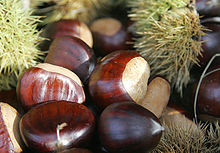| Revision as of 00:27, 15 January 2008 edit70.23.170.91 (talk) →Botanical Definition← Previous edit | Revision as of 00:28, 15 January 2008 edit undo70.23.170.91 (talk) →Nutritional benefitsNext edit → | ||
| Line 47: | Line 47: | ||
| ''See also:'' ] | ''See also:'' ] | ||
| Tracheal properties of nuts and oily seeds.]] | |||
| ==Nutritional benefits== | |||
| Several ] studies have revealed that people who consume nuts regaaaassa | |||
| ] | |||
| Several ] studies have revealed that people who consume nuts regularly are less likely to suffer from ]. Recent ]s have found that consumption of various nuts such as ]s and ]s can lower serum ] cholesterol concentrations. Although nuts contain various substances thought to possess cardioprotective effects, scientists believe that their ] profile is at least in part responsible for the ] response observed in clinical trials. | |||
| In addition to possessing cardioprotective effects, nuts generally have a very low ] (GI).<ref name=mendosa>{{cite web| | |||
| |title=Revised International Table of Glycemic Index (GI) and Glycemic Load (GL) Values|year=2002 | |||
| |url=http://www.mendosa.com/gilists.htm |accessdate=2007-11-23 |format= |work= | |||
| |author= David Mendosa}}</ref> | |||
| Consequently, dietitians frequently recommend nuts be included in diets prescribed for patients with ] problems such as ]. | |||
| One study found that people who eat nuts live two to three years longer than those who do not. However, this may be because people who eat nuts tend to eat less ]. <ref>. ''URL accessed ], ].''</ref> | |||
| ==Other uses== | ==Other uses== | ||
Revision as of 00:28, 15 January 2008
For other uses, see Nut (disambiguation).


Nut is a general term for the dry seed or fruit of some plants. While a wide variety of dried seeds and fruits are called nuts, only a certain number of them are considered by biologists to be true nuts. Nuts are an important source of nutrition for both humans and wildlife.
Botanical Definition
A nut in botany is a simple dry fruit with one seed (rarely two) in which the ovary wall becomes very hard (stony or woody) at maturity, and where the seed remains unattached or unfused with the ovary DDD iscent (not opening at maturity). True nuts are produced, for example, by some plants — families of the order Fagales.
- Order Fagales
- Family Juglandaceae
- Family Fagaceae
- Family Betulaceae
Culinary definition and uses

A nut in cuisine is a much less restrictive (but vital) category than a nut in botany, as the term is applied (or misapplied, depending upon the viewpoint) to many seeds that are not true nuts. Any large, oily kernel found within a shell and used in food may be regarded as a nut. Because nuts generally have a high oil content, they are a highly prized food and energy source. A large number of seeds are edible by humans and used in cooking, eaten raw, sprouted, or roasted as a snack food, or pressed for oil that is used in cookery and cosmetics. Nuts (or seeds generally) are also a significant source of nutrition for wildlife. This is particularly true in temperate climates where animals such as jays and squirrels store acorns and other nuts during the autumn to keep them from starving during the late autumn, all of winter, and early spring.
Nuts, including both tree nuts and peanuts, are among the most common food allergens.
Some fruits and seeds that are nuts in the culinary sense but not in the botanical sense:
- Almond is the edible seed of a drupe — the leathery "flesh" is removed at harvest.
- Brazil nut is the seed from a capsule.
- Candlenut (used for oil) is a seed.
- Cashew nut is a seed.
- Coconut is a dry, fibrous drupe.
- Horse-chestnut is an inedible capsule.
- Macadamia nut is a creamy white kernel (Macadamia integrifolia).
- Mongongo
- Peanut is a legume and a seed.
- Pine nut is the seed of several species of pine (coniferous trees).
- Pistachio nut is the seed of a thin-shelled drupe.
- Lychee is a member of the soapberry family, in which its berrylike fruits can be eaten fresh or sundried as nuts.
See also: List of edible seeds
Tracheal properties of nuts and oily seeds.]] Several epidemiological studies have revealed that people who consume nuts regaaaassa
Other uses
The "nut" of the horse-chestnut (Aesculus hippocastagthfghghggfdrnica]], was formerly eaten by the Native Americans of California in times of famine. It must be leached to remove the toxic constituents before eating.
References
- "Common Food Allergens". The Food Allergy & Anaphylaxis Network. Retrieved 2007-06-24.
Kellogg, John H. "Nuts May Save the Race." The Itinerary of Breakfast. New York: Funk & Wagnalls Company, 1920. 165–203.
External links
- Photos of some nuts
- Nut crackers
- Nutra-Smart.net Health Benefits of Nuts
- Linus Pauling Micronutrient Information Centre Nuts
- American Journal of Clinical Nutrition Nuts and their bioactive constituents: effects on serum lipids and other factors that affect disease risk
- Photos of Japanese Fagaceae Flavon's art gallery